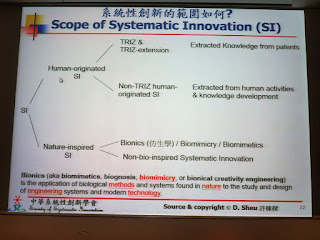(Left: Dr. KS Chin (CityU), Dr. Prof. Singpurwalla, Nozer D. (CityU), Prof. D. Daniel Sheu (NTHU), I and Dr. TW Liu (HKSQ))
Dr. KS Chin introduced Prof. D. Daniel Sheu’s background to us. Prof. Sheu has 9 years of industrial experience primarily in the electronic industries with Hewlett-Packard, Motorola and Matsushita before joining National Tsing Hua University. In his 19-plus years of academic experiences, he paid more than 250 visits to various factories and facilitated more than 100 sessions of industry training courses (> 30 companies). He is expert in TRIZ and Systematic Innovation.
Prof. D. Daniel Sheu introduced the outline of this seminar and then briefed the differences between random innovation (e.g. Brain Storming) and systematic innovation (e.g. TRIZ).
In the beginning, Prof. Sheu asked us why distribution of value for iPhone in 2010 that Apple profits was 58.5% but China Labor cost was 1.8% and Taiwan Profits was 0.5%. Then he used Smile Curve to explain that the most value added parts either in “Product/Service Innovation” or “Branding/Services/Marketing”.
Then Prof. Sheu discussed the scope of systematic innovation (SI) which included Human-originated SI and Nature-inspired SI. Bionics became more and more popular but it had not developed systematically.
Prof. Sheu said Taiwan patents per million populations were ranked number 1 from 2000 to 2008. However, number of patents granted per year by South Korea had over Taiwan since 2007.
One of reasons was Korea industries (e.g. Hyundai & Samsung) employed TRIZ as systematic innovation (not random) which was the most important in Engineering. After Prof. Shen studied Samsung practices, he identified 8 Dimensions and 20 key success factors. The most important dimension was “Adopt Open Innovation & Innovation Methods”.
The definition of TRIZ was mentioned in Russian words and Chinese Translation. TRIZ was created by Mr. G. Altshuller.
The TRIZ model of problem solving was shown as following diagram, where PI stand for Psychological Inertia. It means that people often see things based on their own experience/thinking patterns and look at the things on the space/times/interface of where it appears. (We don’t see things as they are, we see things as we are.)
And then Prof. Sheu introduced Patent Circumvention and also brief Trimming technique with some semiconductor equipment cases.
The roadmap of systematic process of systematic innovation with 5 phases and 8 stages were introduced.
Q&A session
Some participants asked if TRIZ could use in the field of Chemistry or Biotechnology. Prof. Sheu said Chemistry was comparative difficult but still have some cases.
Members of Hong Kong Society for Quality (HKSQ) and Institute of Systematic Innovation Hong Kong (ISIHK) supported the seminar and we took a group photo.
(Left: Dr. Aaron Tong (HKSQ), Mr. SW Lam (HKSQ), Dr. Michael Li (ISI), Prof. D. Daniel Sheu (SSI), Dr. KS Chin (HKSQ), I (HKSQ & ISI) and Dr. TW Liu (HKSQ))
Reference:
HKSQ - www.hksq.org
ISIHK - http://www.isi.org.hk/ The Society of Systematic Innovation, Taiwan (SSI) (中華系統性創新學會) - www.ssi.org.tw
Prof. D. Daniel Sheu’s course in HK:
20150518-19: MA TRIZ Certification Level 2 Training (Part 1) - http://qualityalchemist.blogspot.hk/2015/05/ma-triz-certification-level-2-training.html
20150525-26: MA TRIZ Certification Level 2 Training (Part 2) - http://qualityalchemist.blogspot.hk/2015/05/ma-triz-certification-level-1-training.html













沒有留言:
發佈留言